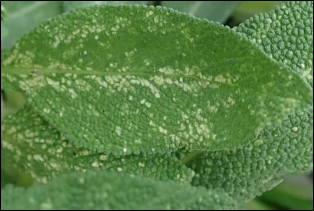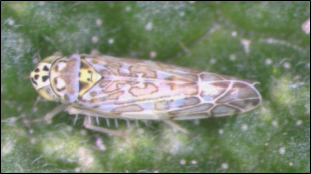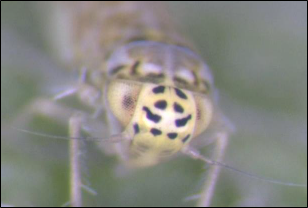Ligurian Leafhopper
ID
ENTO-412NP
Introduction
On April 13, 2020, damage was detected on common sage, Salvia officinalis, in a demonstration garden in central Virginia. Damage presented as flecks of yellow across the green leaf blade (Fig. 1), with greater damage seen on older leaves and less on newer leaves. No insects were immediately seen on the leaf surfaces, but numerous, unidentified leafhopper nymphs were detected on the underside of the leaves under stereomicroscopy. Several adult leafhoppers were collected on additional plant samples. These were identified as Eupteryx decemnotata, the Ligurian leafhopper (Hemiptera: Cicadellidae).

Hosts
The Ligurian leafhopper attacks members of the Lamiaceae or mint family, a group containing numerous aromatic herbs and shrubs (Nickle and Holtzinger 2006; Rung et al. 2009). Favored hosts include basil, mints (including catnip and peppermint), lemon balm, oregano, rosemary, sage, and thyme.
Identification
The insect is extremely small, approximately 3 mm (0.1 inch) long, and has a strikingly beautiful pattern of polygons on the wings in varying shades of blue and brown (Fig. 2).

The Ligurian leafhopper can be separated from other members of the genus Eupteryx by the five pairs of dark spots on the head between the eyes (Fig. 3) (Rung et al. 2009). The related sage leafhopper, E. melissae, can be confused easily with E. decemnotata, but only has 5-7 total spots on the head. The sage leafhopper is widely found in the US where herbs are grown.

Life History
Ligurian leafhoppers have an incomplete life cycle consisting of the egg, nymphal, and adult stages. Eggs that overwintered in leaf tissue hatch when warming spring temperatures reach 68° F. The nymphs are green with noticeable bristly hairs on their bodies. After passing through five nymphal instars, they molt into the adult stage (Fig. 2). Development from egg hatch to the adult stage occurs in 20 days. After mating, females insert their eggs in leaf tissue of host plants. Several generations a year have been reported from Europe (Nickel and Holzinger 2006). Both nymphs and adults are active hoppers, but only adults can fly.
Distribution
This leafhopper is native to the Ligurian Sea, an area in the Mediterranean Sea associated with the northwest Italian coast near France. The Ligurian leafhopper began expanding its range into northern and western Europe in the late1980s, probably due to commercial horticultural trade (Nickle and Holzinger 2006). It was detected in the UK in 2006. The leafhopper was intercepted in 2008 in California (Rung et al. 2009) and there have been sporadic detections in 8 other states (FL, HI, NC, NM, NY, PA, UT). Anecdotal reports indicate this insect may have been seen in Virginia prior to 2020.
Damage
The Ligurian leafhopper is a mesophyll-feeding insect. It damages plant foliage by removing plant cell contents, leaving an empty void that turns yellow and necrotic (Rung et al. 2009). Over time, insect feeding produces an overall stippling pattern on the leaves (Fig. 3). Feeding damage can reduce the quality and yield of the affected plants and can reduce the value for fresh market, essential oil, and herbal supplement industries.
Control
Manual removal of damaged leaves early in the infestation may temporarily reduce the Ligurian leafhopper population by removing eggs before they hatch. Organic controls may provide some assistance while allowing for beneficials such as lacewings, lady beetles, and spiders to reduce leafhopper populations.
Another control option is to treat with a registered insecticide following recommendations found in the current Horticulture and Forest Crops Pest Management Guide (VCE Publication 456-017) for commercial growers, or in the Home Grounds and Animals Pest Management Guide (VCE Publication 456-018) for home owners. As with all pesticides, follow the label instructions carefully with regards to rates and precautions, including days-to-harvest and other restrictions.
References
Nickle, H. and W.E. Holzinger. 2006. Rapid range expansion of Ligurian leafhopper, Eupteryx decemnotata Rey, 1891 (Hemiptera: Cicadellidae), a potential pest of garden and greenhouse herbs, in Europe. Russian Entomol. J. 15: 57-63.
Rung A., S.E. Halbert, D.C. Ziesk DC, and R.J. Gill. 2009. A leafhopper pest of plants in the mint family, Eupteryx decemnotata Rey (Hemiptera: Auchenorrhyncha: Cicadellidae), Ligurian leafhopper, new to North America. Insecta Mundi 88: 1-4.
Virginia Cooperative Extension materials are available for public use, reprint, or citation without further permission, provided the use includes credit to the author and to Virginia Cooperative Extension, Virginia Tech, and Virginia State University.
Virginia Cooperative Extension is a partnership of Virginia Tech, Virginia State University, the U.S. Department of Agriculture (USDA), and local governments, and is an equal opportunity employer. For the full non-discrimination statement, please visit ext.vt.edu/accessibility.
Publication Date
February 12, 2021



